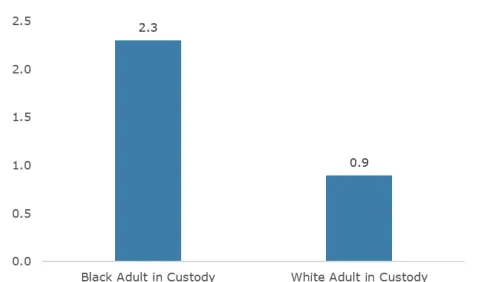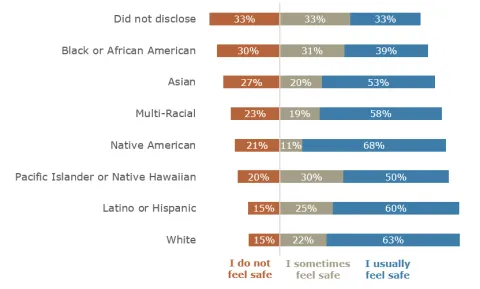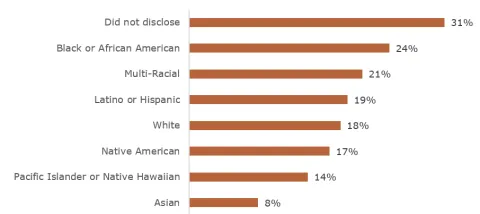Sheriff's Office needs to address use of force, particularly against Black adults
Use of force is always an important issue in jails and prisons, and it came to the forefront with the Sheriff’s Office in 2015, when an internal report suggested that Sheriff’s Office staff were subjecting some racial and ethnic groups to a disproportionate use of force. The report concluded that the issue needed to be studied further, and the Sheriff’s Office brought in the National Institute of Corrections to help start the review process. We found Sheriff’s Office procedures to be consistent with standards, but also found racial disparity in use of force incidents as described in detail below.
Use of force describes a broad range of actions
Use of force includes a wide spectrum of actions. The Sheriff’s Office categorizes uses of force as minor or general, with general being a higher level of force. During the three-year period we reviewed, there were 656 use of force incidents in the housing areas of the jails; deputies often used more than one use of force technique per incident. The following shows the types of use of force and how often they occurred in the jails.
General force types
- Type: Control Technique
- Definition: Control techniques applied to a part of the body to gain compliance. This includes carry, directional control, and joint control.
- Occurrences in jail housing in a three-year period: 722
- Type: Restraint
- Definition: Tools physically applied to partially or completely restrict mobility. These include arm restraint band, restraint chair, restraint board, and flex cuffs.
- Occurrences in jail housing in a three-year period: 140
- Type: OC (pepper spray)
- Definition: Oleoresin Capsicum (pepper spray) sprayed on a person to gain compliance.
- Occurrences in jail housing in a three-year period: 100
- Type: Strikes
- Definition: A focused strike to the person’s body.
- Occurrences in jail housing in a three-year period: 89
- Type: Takedowns
- Definition: Techniques where the deputy physically takes the person down to the floor or ground. These include arm, hair, joint, leg, leg sweep, and tackle.
- Occurrences in jail housing in a three-year period: 87
- Type: Taser
- Definition: A device that provides temporary electrical stun control through the projected probes or pushing directly against the body without a probe cartridge.
- Occurrences in jail housing in a three-year period: 75
- Type: Pressure points
- Definition: When pressure was physically applied to part of a body in an effort to gain compliance through pain or restrict mobility.
- Occurrences in jail housing in a three-year period: 8
- Type: Impact
- Definition: Impact weapons were tools such as a baton, asp, and long bat used to take a suspect into custody or to defend the public and themselves.
- Occurrences in jail housing in a three-year period: 1
Minor force types
- Type: Directional Control
- Definition: Use physical strength to push someone in a direction to gain control of the subject in response to resistance from the subject.
- Occurrences in jail housing in a three-year period: 104
- Type: Point Taser
- Definition: When a Taser was pointed at an adult in custody, but not used.
- Occurrences in jail housing in a three-year period: 100
- Type: Hold against surface
- Definition: Hold someone against a surface.
- Occurrences in jail housing in a three-year period: 96
- Type: Escort hold
- Definition: One of the deputy’s hands was around the person's wrist and part of the hand, and the other hand was placed just above the elbow.
- Occurrences in jail housing in a three-year period: 92
- Type: Handcuff hold
- Definition: When handcuffs were used on an adult in custody.
- Occurrences in jail housing in a three-year period: 45
Source: Multnomah County Sheriff’s Office data for July 1, 2018 through June 30, 2021. Data analyzed by Multnomah County Auditor’s Office staff. Definitions from Multnomah County Sheriff’s Office and U.S. Department of Justice. Only includes use of force in the housing areas of the jails.
Procedures were consistent with standards
Like the discipline process, the Sheriff’s Office use of force policies and procedures, as well as the process by which use of force incidents were reviewed, were consistent with standards set out by the Oregon State Sheriffs’ Association. In addition, the Sheriff’s Office has taken steps to implement many of the recommendations from the 2016 National Institute of Corrections review. These recommendations ranged from changes to jail facilities — with the installation of additional video cameras in MCDC — to new training on de-escalation strategies in potential use of force situations. Most recently, the Sheriff has hired a use of force inspector from outside the ranks of the corrections staff.
Uses of force were infrequent, but Black adults in custody were twice as likely to be subjected to them
We conducted an analysis of use of force incidents within the jails, rather than in the booking or release areas. The scope of this audit was on conditions within the housing portion of the jail.
We analyzed the impact of race and adjusted for other factors, such as age, gender, the amount of time spent in jail, and the individual’s mental health status. It was important to include many different demographics in our analysis because some demographic groups, such as younger people, may be more likely to be subjected to uses of force. A larger percentage of younger adults in custody are Black, so we wanted to know if the uses of force were related more to age or race. Using a multiple regression, we found that in every age group, deputies used more force against Black adults in custody, so it was not just an issue of age, but also one of race. No other race experienced this disparity across every age group.
We found that Sheriff’s employees used force on Black individuals more than those of other racial backgrounds. For uses of force listed as general in the table above, the differences among racial groups were not statistically significant, meaning that differences in the data may be due to chance. Again, for all of our statistical analyses, we used the strictest standard for determining whether differences were statistically significant. General uses of force on Black individuals occurred at a rate outside this strict standard.
For uses of force that the Sheriff’s Office defines as minor, differences in use of force were statistically significant. While the increased use of force for minor events for Black adults in custody was small (about a one percentage point increase in the likelihood), the statistical significance means there was a very low probability that the differences were due to chance.
Minor uses of force were infrequent, but Black adults in custody were more than twice as likely to be subjected to them
Number of minor uses of force per 100 people housed in jail

We did not assess for statistical differences based on the severity of the offense because the literature shows that this was not predictive of behavior in jail. We did not look at prior history of incarceration since we lacked access to this data for other jurisdictions.
We followed our data analysis with our survey of adults in custody to obtain an understanding of their perceptions of how Sheriff’s Office staff use force in the jails. The results of the survey were consistent with the analysis of use of force data, with Black or African American individuals feeling less safe from deputies and that force was more likely to be used as punishment.
Black adults in custody and those who did not disclose their race said they felt the least safe with corrections deputies
Survey question: Do you feel safe from corrections deputies while you were in jail?

Black adults in custody and those who did not disclose their race were more likely to say that corrections deputies use force to punish people
Survey question: When corrections deputies use physical force, was it to: (percent selecting “punish people”)

The National Institute of Corrections report on use of force in the Multnomah County jails pointed out some significant shortcomings in the Sheriff’s Office’s ability to use data to better understand use of force in its facilities. The report stressed the importance of being able to use data to monitor and audit use of force activities, but that the current system did not include the detail necessary to do this sort of work.
Our review of the available data led to similar conclusions. For example, we weren’t able to easily identify which staff members were involved in use of force incidents, so we couldn’t identify which staff members warranted closer scrutiny in the way we could with misconduct citations. The Sheriff’s Office Use of Force Inspector told us that they were in the process of purchasing a new data system for recording and monitoring use of force incidents that will address the shortcomings of the previous system.
